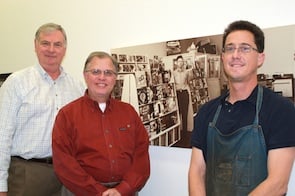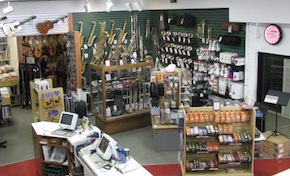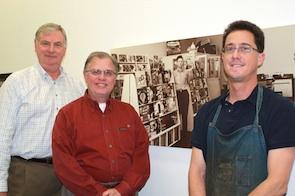
A journey to Grand Avenue in South San Francisco feels like a trip back to a happier era in American commerce, when going downtown meant meeting folks you know and like doing business with. Walk into the Bronstein Music store at 363 Grand and the feeling follows, gaining a musical soundtrack. That soundtrack, as you take it all in, might include the Count Basie Orchestra, on the flat-screen hanging above the entrance to the shop, near the racks of holiday sheet music; the happy banter exchanged between customers and the friendly staff; the delightfully disparate mix of student squeals and peeps leaking out from the teaching rooms down the hall; and the buzzing and tapping of tools in the repair shop, at the far end of the building.
“Our store has always been different than most of the music stores in the Bay Area,” announces co-owner Rich Welker, “’cause we do everything.”
Another holdover from the past, along with the spirit of complete customer service, is respect for the store’s late founder, whom Welker and fellow owner Don Edwards still refer to as “Mr. Bronstein.” Milton Bronstein and his wife, Celia, began their business down the block from its current location, in 1946. Milton had served as General George S. Patton’s bandleader, led the Sixth Army Band (including future jazz legend Paul Desmond) at the Presidio of San Francisco, and taught for a year, but he was eager to invest his military savings in a store in a town with a well-defined and easily accessible main street. His and Celia’s outreach to the community included a policy of hiring students from its two secondary schools, South San Francisco High School and El Camino High School. This brought in Edwards and Welker, in 1968, during a period when well-funded school music programs and a proliferation of garage-based rock ’n’ roll bands made it profitable for the Bronsteins to rent out instruments and equipment.

A music store’s inventory was broader back then, extending to TVs, stereos, and records, as well as band and “combo” instruments and equipment, along with acoustic and electric keyboards. And the associated tasks were multiple. “Mr. Bronstein was exceptionally good at giving all the employees, including ‘the boys,’ as much responsibility as we could take,” recalls Welker. “We weren’t just here to dust, sweep, and mop, though we did that too. They taught us how to do bookkeeping, everything a retail operation has to do, and we also sold and helped customers on the floor.”
“People would want to hear the records, many of them being young girls, so I’d stand at the counter and play them,” says Edwards. “That was a good reason to work here: girls.” Another reason was valuable exposure to a variety of instruments, bolstering what the two young men were picking up in their public schools. Edwards played a variety of horns, while Rich became an accomplished trumpet player.
They also benefitted from their in-store “second mother,” Celia Bronstein. “She was the bookkeeper, and the head nag,” testifies Welker. “Some customers weren’t really qualified to rent, but she would get to know them,” adds Edwards. “And if they were late on the payment, she’d call ’em — really old school.”
College took “the boys” away, for a while. Edwards got married, joined the Army Reserve Band, and worked for Western Electric. Welker kept working for Bronstein, except for one year of college in Los Angeles. Edwards was persuaded to rejoin his former boss and colleague in 1976, a year after the store’s move to its current larger location. Five years later, Welker and Edwards purchased the business from the Bronsteins.
“Janis Joplin bought a Goya classical guitar from us,” notes [co-owner Rich] Welker. “The Pointer Sisters rented from us.”
The new owners maintained the Bronsteins’ prominent presence in South San Francisco. Milton had led a local accordion band and served on the Grand Jury and as a member of the Kiwanis Club and the Better Business Bureau, and his wife was connected with the Salvation Army and the Boys Club. Both Welker and Edwards have been involved with the Downtown Merchants Association and the Chamber of Commerce, as well as Kiwanis.
Face the Music by Changing Owners
The store itself was in good health when it changed ownership, with a long and strong reputation both local and global. “You would come here because your parents had brought you here,” says Edwards. “The history was of a place that felt safe to come to, with everything here, and employees that could speak knowledgeably about all of it.” The inventory, for sale and rent, was also renowned. “Janis Joplin bought a Goya classical guitar from us,” notes Welker. “The Pointer Sisters rented from us, and so did Jethro Tull and Saul Zaentz.
“We stocked horns that no other store in the country would stock,” he continues. “La Scala bought a couple of Schilke horns, ’cause we were the only store in the world that had ’em. They needed four-valve G trumpets for some opera they were doing. For 25 years, we were one of the top brass shops in the world. We had a world map in the back with pins, and every continent in the world, we’d sold horns to, except Antarctica. We had tremendous inventory, particularly trumpet, ’cause that’s what I know, and Wynton Marsalis bought piccolo trumpets from us.”
Time did wreak changes in inventory, though. TVs and stereos made way in the ’70s for more instruments, and organs and pianos were displaced by smaller units. The store boasted a display case of 10 saxophones of various sizes worth about $50,000, until Edwards started to realize that customer reaction wasn’t resulting in sales. “It got to the point where people would come in, look at them, try them, and walk out the door, not even asking the price. We’d become the showplace for Selmer, so customers would know what to order on the Internet.”
“There was a particular Internet operation that decided he wanted it all, so he lowered his prices to 10 percent over cost,” Welker relates. “And we were charging nine-and-a-quarter sales tax. If I’d met his prices, I’d be making 1 percent on really expensive instruments.” Internet availability also convinced the store to back off from electronic gear.
It made more sense (and dollars) to market affordable band instruments to school kids. “A whole bunch of band directors around here are people we grew up with,” Welker points out. “Now we have about 225 schools we do business with, and they just totally trust us. I’ll sell you anything you wanna buy, but I’m gonna tell you if I think it’s not the best thing.”
The Bronstein store has also expanded its own music instruction. More teaching rooms were added a year and a half ago, including larger rooms for ensembles and recitals, accommodating about 25 teachers and 280 students, who, Edwards says, are attracted by the store’s multiple functions. “They might come because of the reputation of this store, or because they rented their instrument here, or because they got their instrument repaired here. Thirty percent of them are adults, 70 percent under 18.
“For 25 years, we were one of the top brass shops in the world.” – Rich Welker
“I wouldn’t have a teacher that couldn’t properly start a student,” he insists. “But as you get advanced you’ll have teachers and players who have genres they really enjoy, and we’ll recommend one teacher over another. I have a new guitar teacher from the [San Francisco] Conservatory, classically trained, and I said, ‘You realize you’ll have a lot of 10-year-olds that wanna play Stairway to Heaven, shredding and so forth.’ He said, ‘I have no problem with that, as long as I can teach them to read and play music.’”
When Edwards and Welker took over, instrument repairs were being done by John Labno in his own shop. “So we convinced him it would be better if he were our employee, rather than an independent contractor, so we could give him health benefits and a vacation,” explains Welker. Labno set up a work station near Bronstein’s rear entrance, where he trained and was later joined by Ron Graham, a saxophone player and teacher at the store, and by Jeff Cotton. “Now I work with anything you blow into — all brass and woodwind instruments,” says Graham. “John just does woodwinds, and Jeff does all the string instruments and electronic stuff like amplifiers and keyboards.”
All the Fixin’s for Fixing Instruments
The repair shop draws customers from all over Northern California, of a variety of ages, abilities, and musical interests. Graham has worked for several players from the San Francisco Symphony and Opera, among them tuba virtuoso Zachariah Spellman, “who’s somewhat of a collector, so he gets odd tubas that are often missing parts or don’t work correctly, so I have to make a part or alter something,” Graham comments.
He points out that “classical musicians are very concerned with intonation, which I can improve by aligning the tone hole. A jazz player might be more concerned with speed or response, or wanting to growl or do an effect that a classical musician would never do. They all want their instruments to respond the way they want, and it’s my job to make it happen, regardless of whether they’re gonna play Chopin or Black Sabbath.”
“[Musicians] all want their instruments to respond the way they want, and it’s my job to make it happen.” – Ron Graham
As with the folks in the front of the store, Graham is big on customer service. “We’re not gonna overcharge, we’re not gonna do extra work, and we’re gonna warn people up front about the costs and consequences of what they wanna have done. If a kid brings in a $500 trumpet and it would cost $250 to fix, I’ll be honest with him, and that’s why people come back to me. And it helps to see the same horns over time, ’cause if I do an experiment on it, I want to see how it holds up after two or 10 years.”
Graham’s job at Bronstein has held up notably well, for two decades, “because of Don and Rich. They’re really allowed me from the get-go to do my own thing, whether it’s teaching and repairing at the same time, or allowing me to go out to schools and try to bring in repairs that way. They really value loyalty over anything else, and they pay us well, ’cause they want us to stick around. They’re the best bosses I’ve ever had.”
That’s the way Edwards and Welker always felt about Milton and Celia Bronstein, and they want to keep that feeling going, for employees and customers alike. Welker sums it up, in smiling understatement: “We like to think of this store as just a good hang.”

